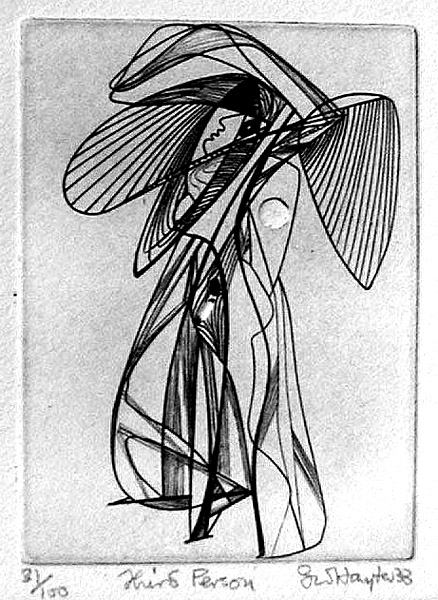Throughout the years, I have been given recommendations by critics and historians of artists to research whose work has a relationship to my own. Helen Harrison, director of the Pollock-Krasner House in East Hampton, suggested I take a look at the work of Stanley William Hayter (December 27, 1901, London – May 4, 1988, Paris) .

Stanley William Hayter, Third Person (Nostradamus, 1935) (Black/Moorhead 122). Original engraving, 1935.
Hayter was a British painter and printmaker associated in the 1930s with Surrealism and from 1940 onward with Abstract Expressionism.
The artist has an interesting background; He received a degree in chemistry and geology from King’s College London and worked in Abadan, Iran for the Anglo-Persian Oil Company from 1922 to 1925. After Hayter returned home to convalesce from an attack of malaria, his company arranged a one-man show at their headquarters in London of the paintings and drawings he had made while overseas.

Stanley William Hayter, Cheiromancy (Black/Moorhead 89). Original engraving, 1935.
Hayter acted as advisor to the Museum of Modern Art for the show Britain at War. Interestingly, in connection with the exhibition, he devised an analog computer to duplicate the angle of the sun and shadow lengths for any time, day and latitude.
Hayter continued to develop painting alongside printmaking. His interest in automatism led him to associate with the Surrealists, and in the United States he was an innovator in the Abstract Expressionism movement. In 2005 the Tate Archive acquired Hayter’s papers.
I had not known about Hayter or his work prior to Harrison’s suggestion, but upon looking at his images, I can definitely see a connection to my own work – both in terms of the integration of printmaking as a medium, as well as the imagery, which seems to draw on the surrealist concept of automatism, as well as abstract expressionist thoughts. The forms pictured here are at once organic and mechanistic, with a strong relationship to some of the digitally-assisted wireframe forms of my own. It is always interesting to discover art-historical references that relate to my own work. I find that time spent doing this sort of research can only enrich the objects and images that I create in the studio.
(factual references: Wikipedia; images: Spaightwood Galleries)
